Nature-based solutions to natural hazards in the Pyrenees: closing seminar and presentation of PHUSICOS demonstration sites
PHUSICOS has enabled the development of nature-based solutions to reduce the risk posed by extreme weather events in rural mountain landscapes in four sites in the Pyrenees: Capet, Artouste Santa Elena and Erill la Vall.
The implementation of these solutions, the work with partners and stakeholders has revealed benefits, difficulties and lessons that the Pyrenean Climate Change Observatory of the Working Community of the Pyrenees (OPCC-CTP) wanted to organise at an event, the aim of which was to present the work carried out in depth, and to pool and share the lessons learned among public and private actors in the area. Among the benefits are the achievement of solutions that are much more adapted to the needs and that respond better to the problems of climate change, the involvement and dynamics generated with local resources and employment. The difficulties to be addressed include the administrative procedures for authorising works, the legal responsibilities of those responsible for the works, the problems related to the definition of the projects and the difficulties related to the skills and knowledge of local companies when implementing this type of solution to deal with natural risks.
The OPCC-CTP, in collaboration with PHUSICOS partners involved in the Pyrenees demonstration site, organized:
- A one-day training course on April 11, 2023, with the objective of introducing participants to the main biological engineering techniques, especially adapted to mountain environments.
- A results seminar on April 12, 2023, with the objective of presenting the results obtained in the framework of PHUSICOS and discussing the performance of nature-based solutions to cope with natural hazards in mountain areas.
The objective of the event was thus to increase the commitment of local authorities and key stakeholders to nature-based solutions to natural hazards, to foster a space for free exchange among peers on the challenges, successes and failures in developing nature-based solutions to natural hazards in their territories, and to enrich and learn from the exchanges to improve progress towards standards and regulations.
The two-day event was aimed primarily at authorities and technicians from public forestry and road administrations, small and medium-sized companies in the timber and construction sectors, and consultancies specializing in natural hazards, geotechnics, etc.
More than 150 invitations were sent to authorities and technicians from neighboring municipalities affected by natural hazards, chambers of commerce and industry in the Pyrenees, small and medium-sized enterprises in the timber and construction sectors, municipal, departmental and regional authorities responsible for road management and maintenance, consulting firms, environmental protection associations, research centers, etc.
The training day on April 11, 2023 was attended by 26 participants from local authorities, companies and associations. On April 12, 2023, 32 people attended the results seminar, with the remaining participants coming mainly from municipal authorities.
The main presentations at the event were given by invited members of the European Federation of Soil Bioengineering (EFIB), EIFORSA, a company specialized in the wood sector, the technicians responsible for the definition of the BSS in each of the four sites where PHUSICOS intervened (Alain Bruzy, Santiago Fábregas and Carles Raïmat), the expert in participatory techniques associated with the Living Labs of Santa Elena, Artouste and Erill la Vall (Xavier Carbonell) and the mayors of the villages of the four sites (Robert Casadebaig, Pascal Arribet, Jean-Louis Noguère and Sònia Bruguera). In addition, three PHUSICOS partners, the Center for Ecological Research and Forestry Applications (CREAF), the Bureau of Geological and Mining Research (BRGM) and Risk & Development (R&D; Risques & Développement) attended the event and presented their work on the development of the NBS in the Pyrenees demonstration site. CTP presented on behalf of the University of Geneva (UNIGE; Université de Genève) and the International Institute for Applied Systems Analysis (IIASA), which sent a presentation focusing on barriers to NBS, comparing them to gray infrastructure and examining the perceptions of private entrepreneurs.
For more information:
- Seminar posters and programs.
- Introduction to Bioengineering Handbook (EFIB)
- Presentations of the training day (11/04/2023)
- Presentations of the results seminar (12/04/2023)
- The document containing the discussions, conclusions and recommendations for implementing nature-based solutions in mountain areas.
Snow avalanches in the Capet forest
Barèges and Sers are two villages located at the bottom of the slopes of the Capet state forest, in the Hautes-Pyrénées department of the Pyrenees. The two villages have a permanent population of around 300, which doubles or triples during the summer and winter seasons, due to the appeal of winter sports in the valley.
The site is threatened by snow avalanches in the "Midaou" avalanche corridor. Avalanches can reach the village of Barèges, which has happened several times in the past, most recently in 2013. The slope and the trigger zone contain numerous old "grey" protection structures, the first of which date back to the mid-1800s, making up a veritable "museum of avalanche protection structures". Due to the direction of the prevailing winds, the snowpack can rise above the existing structures by around 4m. In 2013, the avalanche was first triggered in the top 0.3 m of snow, exceeding a snow height of 4 m. The grey measures are designed to protect against avalanches with a return period of 100 years. These structures are intended to coexist with the new natural solutions implemented by PHUSICOS.
The nature-based solutions developed by PHUSICOS since 2020 consist of reforestation by planting trees of 9 different species (Pinus uncinata, Larix decidua, Abies concolor, Picea engelmanii, Pinus cembra, Pinus ponderosa, Pinus bougetii, Pinus sylvestris, Cedrus deodora), all proven to be best suited to the climate and altitude of the site (between 1800 and 2200 m). The plants are protected either by 88 newly-constructed wooden tripods, by existing grey structures, or by existing groups of natural trees. The wooden tripods are also intended to act as avalanche protection structures. This function is particularly important in bare areas where there is little or no vegetation or grey structures.
Discover the site and the testimonials of the project's main stakeholders in a 3-minute video on our YouTube channel.

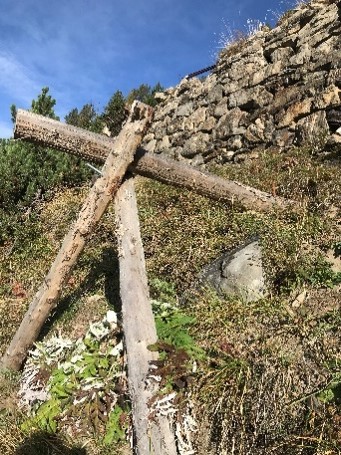
Rockfalls at Artouste
The site is adjacent to the Artouste hydroelectric dam, where the RD-934 road curves down from the reservoir level to the base of the dam. The site is located in the commune of Laruns.
The hazard at Artouste is caused by rockfalls, both from exposed rock ledges and from loose boulders resting on the till surface on the steep slope. The slope is steep and rockfalls often hit the road, causing dangerous situations. In 2013, a fatal accident occurred when a car was hit by a boulder. The road is heavily trafficked and is a strategic link between France and Spain. Average traffic density in Artouste exceeds 1,000,000 vehicles per year.
The nature-based solutions developed by PHUSICOS consist of various structures made of wood and/or local stone. The solutions are based on active measures (manual stabilization and/or wooden structures) to stabilize source areas, and on passive measures (mixed wood and/or stone structures) to slow down and/or stop boulders in their tracks, thus reinforcing the protective role of the forest. To complement the NBS intervention, test facilities for NBS boulder-fall measures have been set up at La Peña Estación, Spain, on the premises of the timber company, and on an open-air site at Gourzy, France, with characteristics similar to those at Artouste.
Discover the site and the testimonials of the project's main stakeholders in a 3-minute video on our YouTube channel.

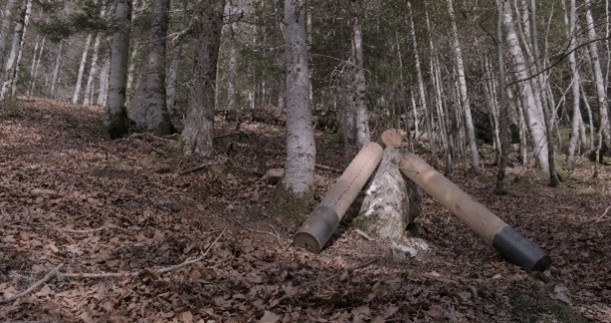
Unstable moraine slope at Santa Elena
The Santa Elena slope has been highlighted as one of the high-risk sites along the A-136 road, a major route between Spain and France (known as the RD-934 in France). The site is located in the heart of the Pyrenean valley of Tena, which attracts summer tourists for hiking and, in winter, the Formigal ski resort.
Numerous incidents involving rocks and/or debris on the road have occurred in the past along this stretch of the A-136, but few serious accidents have been reported. Speeds are often high and visibility is poor due to the terrain, so there is little time to react if obstacles fall onto the road. The road receives heavy traffic and is a strategic axis between France and Spain; the average traffic density in Santa Elena is over 4,000 vehicles per day.
The measures implemented by PHUSICOS at Santa Elena consist of terraces formed by a dry masonry wall 5 m high at the base, followed by 10 terraces built of logs. The log constructions take the form of wooden gabions, filled with local sediments and topped with a 10 cm layer of organic soil for the planting of shrubbery on the terraces. All the plants used are local and adapted to the climate, altitude and local geology (glacial till) (Pinus sylvestris, Betula pendula, Sorbus aria, Populus nigra, Salix capraea, Hippophae ramnoides and Salix eleagnos). Hippophae ramnoides is a shrub particularly recommended for stabilizing slopes; its roots spread quickly and widely, enabling non-leguminous nitrogen to be fixed in the surrounding soil.
Discover the site and the testimonials of the project's main stakeholders in a 3-minute video on our YouTube channel.
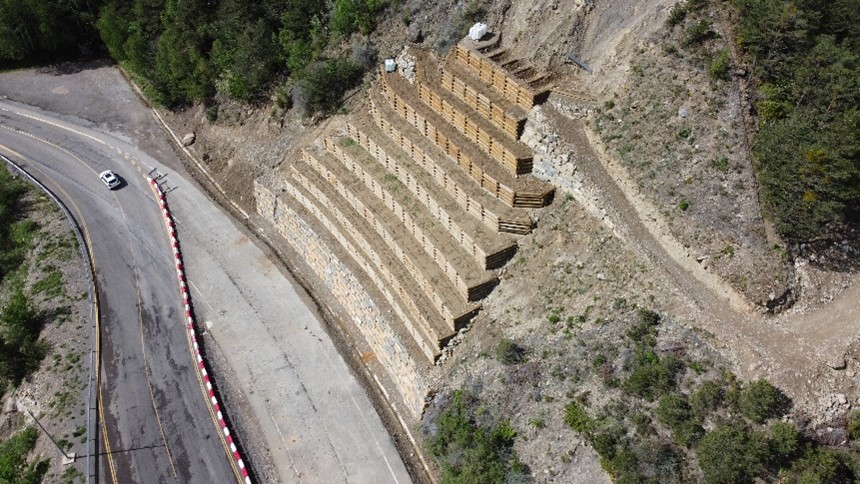
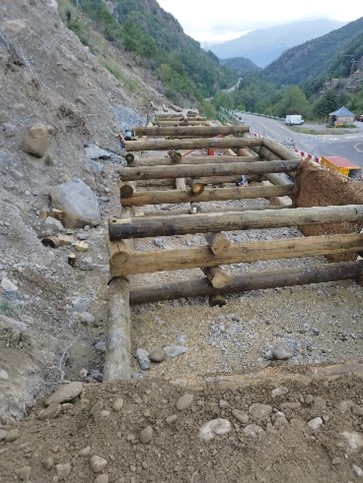
Debris flow mitigation in Erill-la-Vall
Erill la Vall is a village in the Boí valley, Catalonia, located at the bottom of a ravine. The problem at the Erill-la-Vall site in Catalonia, Spain, is erosion and debris flows from a boulder-rich till complex (>50 m). Numerous small gullies feed the main channel of the debris flow, which eventually reaches the village of Erill-la-Vall. This village has already been affected by debris flows in the past. Heavy rainfall triggers an immediate reaction in the surface sediments, with erosion and downward transport of debris and large boulders, which are abundant in the till material. However, a piezometer at 30 m depth shows a response to heavy rains after 10 to 15 days, which may trigger larger and deeper events. One such event occurred in 1907 after a long period of rainfall. NBS are mainly used to mitigate shallow events.
The measures applied by PHUSICOS consist of terraces built with dry stone and timber walls. They are built in the lower parts of the steepest part of the two main ravines. The terraces are covered with organic soil and planted with local vegetation: grass, shrubs and trees. The terraces use local soil and grasses, and natural fertilizers from local grazing animals. Some 2,500 plants in total will have been used, all local species (Betula pendula, Salix purpurea, Salix caprea, Rhamnus alpina, Viburnum opulus, Corylus avellana, Prunus spinosa, Fraxinus excelsior and Salix sp.).
Discover the site and the testimonials of the main actors of the project in a 3-minute video on our YouTube channel.

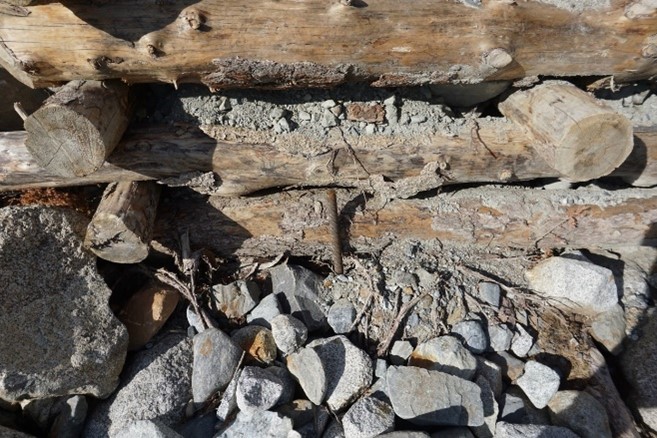
PYRENEAN CLIMATE CHANGE OBSERVATORY
Avenida Nuestra Señora de la Victoria, 8
22.700 - Jaca
Huesca - España
+34 974 36 31 00
info_opcc@ctp.org





